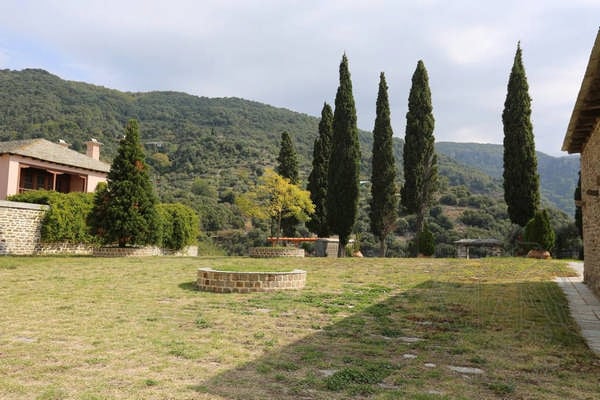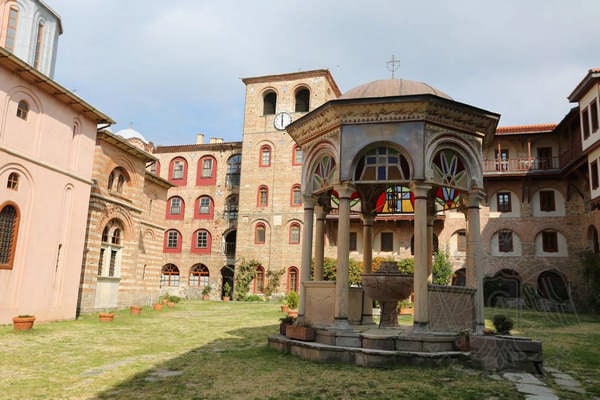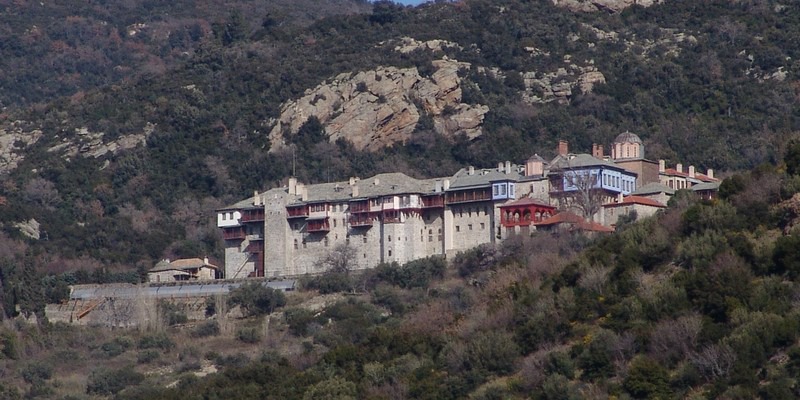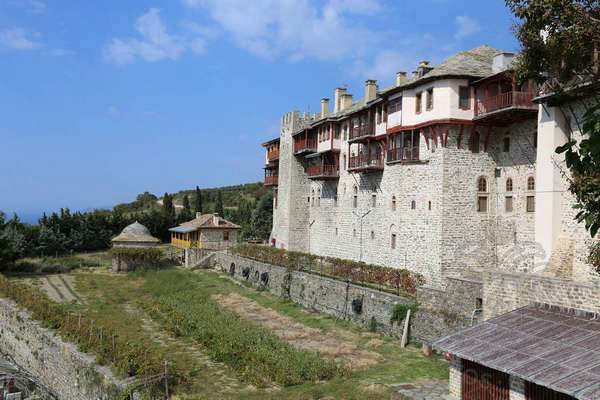History and present days
 The Monastery of Xeropotamou stands on a hillside slope. Its floor plan is almost square, while the three-story wings enhance its fortified character. The domes of the katholikon, the chapels and the bell tower all rise above the wings. In the past there existed more towers, as Barsky's engraving testifies (1744). However, they were destroyed and never rebuilt.
The Monastery of Xeropotamou stands on a hillside slope. Its floor plan is almost square, while the three-story wings enhance its fortified character. The domes of the katholikon, the chapels and the bell tower all rise above the wings. In the past there existed more towers, as Barsky's engraving testifies (1744). However, they were destroyed and never rebuilt.
History
According to the geographer Ptolemy (2nd century AD), the site of the monastery was once home to the ancient city of Stratonikeia, named in honor of Stratonike, the daughter of Demetrius Poliorcetes (294–287 BC). It appears that the city existed during the reign of Justinian (527–565) but was later destroyed by Arab raids.
Tradition holds that the Monastery of Xeropotamou was founded by the Empress Pulcheria (450–457), daughter of the Emperor Arcadius. The Emperors Romanos I Lekapenos (919–944) and Constantine VII Porphyrogenitus (912–959) are also honored as benefactors. In old documents it is also mentioned a "Monastery of Saint Nikephoros of Xeropotamou," whose abbot signed the Monomachos Typikon (1046). However, its identification with the present monastery is uncertain, as Xeropotamos has been known since its foundation as the "Monastery of the Holy Forty," dedicated to the Holy Forty Martyrs. The monastery was also referred to as "Chloropotamos," while its current name is associated with Saint Paul of Xeropotamou, a contemporary of Saint Athanasius the Athonite and the monastery’s first abbot. Historical sources place its foundation in the late 10th century.
The Monastery of Xeropotamou flourished during the 11th and 12th centuries, extending its influence as far as the present-day Monasteries of Simonopetra, Gregoriou and Dionysiou. However, during the Frankish period, the monastery faced a serious decline due to financial difficulties and pirate raids. A fire in 1280 destroyed many of its structures. The Emperor Andronikos II Palaiologos (1282–1328) assisted in its reconstruction, securing its properties through a golden bull.  Serbian rulers followed his example, providing generous sponsorship. Their contributions funded the construction of the defensive wall, the tower and the chapel of the Virgin Mary in the north wing, as well as the reconstruction of the katholikon in 1445.
Serbian rulers followed his example, providing generous sponsorship. Their contributions funded the construction of the defensive wall, the tower and the chapel of the Virgin Mary in the north wing, as well as the reconstruction of the katholikon in 1445.
During the Ottoman occupation, the monastery faced again severe financial hardship due to repeated raids and legal disputes over land ownership. In 1798, courts awarded the Cell of Dontas to the Monastery of Simonopetra and the Cell of Anapausa to the Monastery of Koutloumousiou. Fires in 1507 and 1609 caused further devastation. The Sultan Selim I (1512–1520), grateful for one of his victories that he attributed to the miraculous intervention of the Forty Martyrs, contributed generously to the monastery's reconstruction. By an imperial decree, he secured the monastery’s estates and established an annual grant.
Η Μονή ανακαινίστηκε κατά το δεύτερο μισό του 18ου αιώνα χάρη στις προσόδους των εράνων που έκανε ο μοναχός Καισάριος Δαπόντες, περιάγοντας για προσκύνηση το Τίμιο Ξύλο και τα λείψανα των αγίων Τεσσαράκοντα επί οκτώ χρόνια (1757-65) στις παραδουνάβιες ηγεμονίες και στην Κωνσταντινούπολη. Σε αυτή την ανακαίνιση ανάγονται το καθολικό, η φιάλη και τα παλιότερα τμήματα των πτερύγων που βλέπουμε σήμερα.
In the early 16th century, Xeropotamos held the fifth rank among the Athonite monasteries. However, financial difficulties forced it to keep this position, along with its right to appoint a Protos to the younger Monastery of Dionysiou in exchange for monetary support. Since then, it has held the eighth position.
The monastery underwent a major renovation in the second half of the 18th century, funded by donations that were collected by the monk Caesarius Daponte. Carrying a part of the Holy Cross and the relics of the Forty Martyrs, he traveled for eight years (1757–1765) all through the Danubian Principalities and Constantinople, gathering resources for the monastery’s restoration. In this period the katholikon was reconstructed, together with older sections of the monastery’s wings that remain visible today.
After unsuccessful attempts in 1611 and 1835, the monastery was finally converted into a cenobitic community by a decree of the Ecumenical Patriarch Demetrios I in 1981, when a new brotherhood was settled there.
Caesarius Daponte
Caesarius Daponte was a prominent figure in the Greek intellectual circles of the 18th century. He was a courtier, a scholar and a monk. He was born in the same year that Vitsentzos Kornaros published Erotokritos in Venice. Educated in Bucharest by a scholarship, he later served as a secretary. Imprisoned in Constantinople (1747–1748) together with the Holy New Martyr Christos the Gardener, he sacrificed his entire fortune to ensure his release.
Eighteen months after his marriage in 1749, both his wife and his newborn daughter died, leading him to embrace monasticism in 1753. He first joined the Monastery of Evangelistria, founded by his father in Skopelos, before moving to the Monastery of Xeropotamou. However, three weeks after his arrival, he left on a long journey through Moldavia, Wallachia, Constantinople, Chios, Samos, Psara, Skopelos, and Chalkida, carrying a part of the Holy Cross and gathering donations for the monastery’s reconstruction.
Daponte returned to Xeropotamos from 1765 to 1771. In the meanwhile he arranged for the publication of many of his works in Venice. He later moved to the Monastery of Koutloumousiou (1771–1773), returned to Xeropotamos (1773–1778) and then spent some time at the Monastery of Evangelistria (1778–1784). He eventually returned to Mount Athos, where he passed away six months later.
For the enslaved Greek popularity, the 18th century was a period of spiritual upheaval, as the ideas of the Western European Enlightenment were spread eastward, provoking a strong reaction from the Church. A great schism between faith and intellect emerged at that time.
Daponte's voluminous work remained largely unaffected by these upheavals. Part of its charm undoubtedly lies in its luminous quality, as perceived by modern readers. Equally captivating, however, is the sense of freedom conveyed through the extend and the contradictions of his writings. By contemporary standards, his work combines the often irreverent language of Nikos Tsiforos with the fervent piety of Nikos Gabriel Pentzikis.
Moreover, the name “Garden of the Virgin Mary” used to describe Mount Athos, is attributed to Caesarius Daponte, as reflected in his writings:
"For this reason and for being fair, everyone calls you the Garden of the Virgin Mary."








